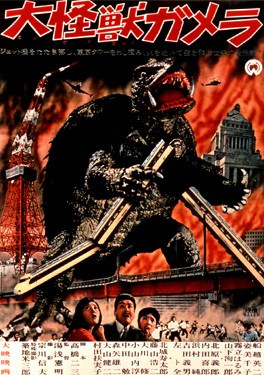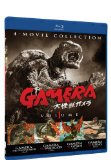| Reviews & Columns |
|
Reviews DVD TV on DVD Blu-ray 4K UHD International DVDs In Theaters Reviews by Studio Video Games Features Collector Series DVDs Easter Egg Database Interviews DVD Talk Radio Feature Articles Columns Anime Talk DVD Savant Horror DVDs The M.O.D. Squad Art House HD Talk Silent DVD
|
DVD Talk Forum |
|
|
| Resources |
|
DVD Price Search Customer Service #'s RCE Info Links |
|
Columns
|
|
|
Gamera: Ultimate Collection, Volume 1 (Gamera the Giant Monster/Gamera vs. Barugon/Gamera vs. Gyaos/Gamera vs. Viras)
The first six Gamera movies were a fixture of 1970s television, often running, as they did in my hometown Detroit market, once or twice annually as part of "Japanese Monster Week" on The 4 O'clock Movie and similar programs. These movies fascinated little boys of that generation, in some respects more even than Gamera's progenitor, Godzilla, the "King of the Monsters." Unlike nearly all the Godzilla movies of that era, most of the Gamera films were told from a child's (or, more often, two or three children's) perspective. They addressed the interests, fears, and imagination-filled minds of 10-year-old boys better than just about any films of any genre, from any nation.
Through the years I became friendly with Noriaki Yuasa (1933-2004), the director of all but one of the eight original movies (he directed the special effects on the other). He was an incredibly kind and generous man, very much a big kid himself. For example, in my apartment once the then nearly 70-year-old Mr. Yuasa got on all fours to demonstrate Gamera's walk. Imagine a senior citizen version of the chubby kid from Gamera vs. Gyaos. Through him I gradually came to realize that what I mistook as many of the series' faults were actually attributes.
By the 1980s, the (mostly AIP-TV) English-dubbed versions of these films we grew up with, the first four then called Gammera the Invincible (1965), War of the Monsters (1966), Return of the Giant Monsters (1967), and Destroy All Planets (1968), were supplanted by infamous "Sandy Frank" versions, with the polished, expressive dubbing overseen by professionals based in New York replaced with appallingly amateurish dubbing apparently done in Japan using non-professional actors. It was these horrendous versions of the films that became fodder for shows like Mystery Science Theater 3000.
Mill Creek, as they did before with their Blu-ray release of Daiei's contemporaneous Majin movies (three movies, all from 1966), have packaged beautiful high-def transfers of the entire Gamera series in multi-volume sets. Retitled Gamera the Giant Monster, Gamera vs. Barugon, Gamera vs. Gyaos, and Gamera vs. Viras, respectively, only the first film, with its strange black-and-white transfer (the others are in color) look less than stellar. There are no extras but for the price who's complaining?
These first four films encapsulate the rollercoaster evolution of the original series, ending just as Daiei spiraled toward the bankruptcy that would force painful budget cuts before temporarily killing off the series in 1971. The first movie was a modestly budgeted Godzilla imitator, rival Toho Studios having already produced six Godzilla movies and a host of other big-scale fantasy films prior to the end of 1965. Several had cracked their year's Top Ten box-office list of domestic releases and, more importantly, almost all of earned significant additional moneys through distribution rights sales abroad, particularly to America.
Daiei once had led the way, selling its biggest movies to the American market and elsewhere, beginning with Akira Kurosawa's Rashomon (1950) and continuing with art house favorites like Ugetsu and Gate of Hell (both 1953). By the 1960s, however, Toho was leading the charge, going so far as to open Toho cinemas abroad to showcase its movies.
Yuasa was the son of respected actor Hikaru Hoshi, a stage name literally meaning "shining star." His son, by contrast, was not well-regarded. Chubby with thick eyeglasses, people on the Daiei lot used to joke he was "beneath his father's shining star." Yuasa got the job to direct Gamera after Daiei's older, more respected filmmakers turned it down. Partly this was because of the movie's relatively low-budget, and partly because it was more like cleanup duty, salvage work when a bigger production, "Swarms of Rats," about Toyota-size rodents attacking Tokyo, was cancelled mid-stream. It was Yuasa's second feature film as director.
But Gamera the Giant Monster, about a giant, fire-breathing flying turtle attacking Tokyo's capitol, proved enormously successful, and quickly sold abroad. The movie was released in late November 1965; by mid-April 1966, the first sequel, Gamera vs. Barugon was, incredibly, already in theaters.
Unlike the modestly-budgeted, black-and-white Gamera the Giant Monster, Gamera vs. Barugon was in color, significantly longer, and filmed on a far grander scale. The sequel, about a band of unsavory types who, in stealing an opal from a South Seas isle unwittingly unleash the colossal lizard Barugon, features scads more extras, grander sets and location work, and far more lavish special effects set piece.
Far too important a project to assign relative neophyte Yuasa to the helm, instead the directorial assignment was given to Shigeo Tanaka (Daiei's "Woman Gambler" series). Yuasa, instead, was put in charge of the film's special effects. It's the only Gamera entry without a child playing a significant role in the story, and arguably the only Gamera movie from the original series seriously trying to reach a broad, mainstream audience, though that doesn't stop it from being extraordinarily silly at times, particularly with regard to the increasingly daft efforts by the military to stomp the rampaging Gamera.
Gamera vs. Barugon must not have been the big success everyone had hoped because from this point on Yuasa and series screenwriter Nisan Takahashi were pretty much left to their own devices and allowed to fashion the annual series as they saw fit. Gamera vs. Gyaos sneaked a child prominently back into its main story, about a flying Pterodactyl-type creature threatening construction of a new highway near Mt. Fuji. The film was quite popular and served as the basis for Daiei's 1995 reboot of the Gamera series, Gamera: Guardian of the Universe, a clever, even ingenious film targeting the by now grown-up generation of Japanese Gamera fans, though Yuasa himself disliked the latter series' decision to abandon his and Takahashi's childlike approach.
Gamera vs. Viras solidifies Yuasa's and Takahashi's aims with its singularly kid-based plot of two Boy Scouts (one Japanese, one American) kidnapped by alien invaders who use the boys as leverage in their conquest of the earth. It also introduced the series' first truly outlandish monster, a squid-like creature with the face of a malevolent parakeet, while its scenes of the boys piloting a miniature sub and exploring the alien's strange UFO enchants.
Video & Audio
If you've only experienced the Gamera movies via panned-and-scanned, English-dubbed home video versions, this set will be revelatory. All were shot in Daieiscope, Daiei's CinemaScope process, and all but the first film were made in color. (Daiei alternated between Eastman and Fujicolor during this period. The latter process has certain advantages, such as richer blues.) As with Mill Creek's release of the Majin films, the transfers are positively glorious. The video transfer elicits an extremely sharp, bright, and color-rich image; on my 90-inch screen the effect was like looking at an absolutely pristine 35mm print. Only Gamera the Giant Monster is less than near-perfect: the image is sharp but the contrast is, well, weird-looking. Some scenes look great but much of the film appears too bright, or washed out, or something, with darker scenes (such as Gamera's attack on central Tokyo) suffering somewhat. The mono audio, in Japanese only, is good, and the English subtitles adequate. They may have been directly culled from Shout! Factory's earlier DVD releases, which have their share of typographical errors and anachronistic/inapt translations. No Extra Features. The lack thereof as well as the absence of alternate audio tracks probably relate to the decision to cram all four movies onto a single disc. The bit rate doesn't suffer too badly, and the decision to preclude this in order to keep the price of the set down is a reasonable compromise.
Parting Thoughts
Extremely fun movies for all ages - at least those old enough to read English subtitles - with excellent video transfers, all at a price too good to pass up, Gamera: The Ultimate Collection, Volume 1 is a DVD Talk Collector series title.
Stuart Galbraith IV is the Kyoto-based film historian and publisher-editor of World Cinema Paradise. His credits include film history books, DVD and Blu-ray audio commentaries and special features.
|
| Popular Reviews |
| Sponsored Links |
|
|
| Sponsored Links |
|
|
| Release List | Reviews | Shop | Newsletter | Forum | DVD Giveaways | Blu-Ray | Advertise |
|
Copyright 2024 DVDTalk.com All Rights Reserved. Legal Info, Privacy Policy, Terms of Use,
Manage Preferences,
Your Privacy Choices | |||||||














